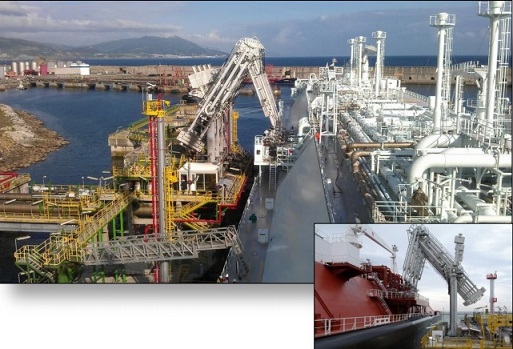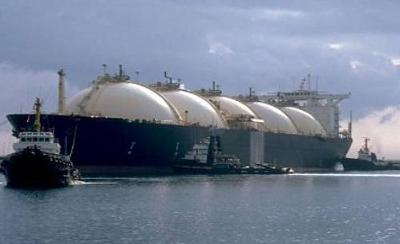

Home page|||
LNG handling |||
LPG handling||| Other Gas products|||
Fire & Safety|||
Emergency response |||
Loading arm leaks - Emergency response for LNG carriers
If the vessel encounters a dangerous situation that may develop into an emergency, it is extremely important that the whole crew know exactly what they should do to save their lives and minimize damage.
The crew must be drilled to take certain actions more or less automatically. However, nobody must act without considering the superfluous consequences.
These plans should be used actively during emergency drills.
Leaks from a Loading Arm due to Tidal or Current Effects or other ships movement
After completing loading, a gas tanker crew secured the accommodation ladder. The terminal had rigged a temporary gangway from the shore for two representatives, who had boarded to disconnect the loading arm. A large tanker passing the vessel, caused it to surge and sway away from the jetty by about two metres. The shore end of the gangway came off the jetty and fell on top of the taut aft backsprings. The crew immediately re-moored the vessel and repositioned the shore gangway. The loading arm was damaged as a result of the incident. All four backsprings were belayed on one bollard, disallowing any countering of athwartship forces

LNG loading arm
The possibility of a leak from a loading arm due to tidal effect is remote. However, a leak could be caused by excessive movement of the vessel whilst alongside. The loading arms are designed to accept a certain movement of the vessel, if the movement exceeds certain limits ESDS is activated and all cargo operations are stopped. If the vessel's movement increases even further the PERC system is activated and loading arms are disconnected immediately.
Watchman at manifold should advise CCR about loading arm leakage, location (which arm) and dimension of the leak. New vessels are equipped with video equipment to monitor the operation and check the extent of any leak. Following actions are recommended:
i) Attend any injured people
ii) Watchman at manifold should apply water on manifold area
iii) Activate manifold spray system, if it is needed
iv) Advise Terminal
v) Make ready Dry Powder Fixed Fire-Extinguishing System. Normally ready while alongside.
vi) If it is a small leak try to wrap leak area with wet rugs or tightening bolts
vii) Check moorings and try to stop ship movement
viii) If leak is considerable. Stop cargo operations. Activate ESDS
ix) Drain loading arms
x) Repair leak if possible
xi) Consider - continue loading / unloading without the leaking loading arm
xii) If more than one liquid loading arm leaking, consider - leave berth until repairs are completed
xiii) Inform Owners, Local authorities, agent, P&I Club
When spilled on water:
Boiling of LNG is rapid, due to the large temperature difference between the product and water.
- LNG continuously spreads over an indefinitely large area, it results in a
magnification of its rates of evaporation until vaporization is complete.
- No coherent ice layer forms on the water.
- Under particular circumstances, with a Methane concentration below 40%,
flameless explosions are possible when the LNG strikes the water. It results from
an interfacial phenomenon in which LNG becomes locally superheated at a
maximum limit until a rapid boiling occurs. However, commercial LNG is far richer
in Methane than 40% and would require lengthy storage before ageing to that
concentration.
- The flammable cloud of LNG and air may extend for large distances downwind
(only Methane when warmer than 100 degree C is lighter than air) because of the absence
of topographic features, which normally promote turbulent mixing.

Related Information:
- Leaks on the Cargo System, Continuous Flow - how to prevent
- Risk of Overfilling of Cargo Tank during Loading
- Compressed air system - Gas carrier immediate actions
- LNG tank leaks and immediate action by gas carriers
- Reactivity of liquefied gas cargo and safety guideline
Risk of Overfilling of Cargo Tank during Loading
Cargo tank ruptures due to increased pressure - emergency procedure for gas carriers
Gas carrier Emergency Procedures for rescue

// Home page///
LNG handling ///
LPG handling///
Sea transport ///
Gas products///
Cargo work
///Fire precautions
///Health hazards
///Safety Precautions
///Emergency response ///

Copyright © Liquefied Gas Carrie.com All rights reserved.
The content published in this website are for general reference only. We have endeavoured to make the information
as accurate as possible but cannot take responsibility for any errors. For latest information please visit www.imo.org .
Any suggestions, please Contact us !
///Links &Resources //
Terms of use///
Privacy policy///Home page///



